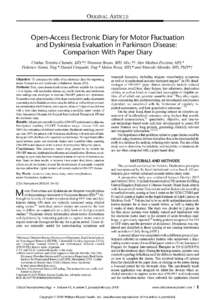Por favor, use este identificador para citar o enlazar este ítem:
https://repositorio.uca.edu.ar/handle/123456789/15115| Título: | Open-access electronic diary for motor fluctuation and dyskinesia evaluation in aprkinson disease: comparison with paper diary | Autor: | Terroba Chambi, Cinthia Bruno, Verónica Medina Escobar, Alex Nanni, Federico Cerquetti, Daniel Rossi, Malco Damián Merello, Marcelo |
Palabras clave: | ENFERMEDAD DE PARKINSON; VIDA COTIDIANA; ENVEJECIMIENTO; DISCINESIA | Fecha de publicación: | 2018 | Editorial: | Wolters Kluwer | Cita: | Terroba Chambi, C.J. et al. Open-access electronic diary for motor fluctuation and dyskinesia evaluation in aprkinson disease: comparison with paper diary [en línea]. Clinical Neuropharmacology. 2018, 41(1) doi:10.1097/WNF.0000000000000264 Disponible en: https://repositorio.uca.edu.ar/handle/123456789/15115 | Resumen: | Abstract: Objective - To determine the utility of an electronic diary for registering motor fluctuations and dyskinesia in Parkinson disease (PD). Methods - Free, open-access touch screen software suitable for Android 4.4 or higher, with medication alarms, adjustable intervals, and medication dose settings was developed to evaluate ON-OFF periods and dyskinesia. Prospective evaluation included a first phase conducted to make adjustments concerning motor limitations when using the tablet, as well as for proper motor complication identification, and a second phase of 3 days of use at home with a prior diary training session comparing a modified paper version of Core Assessment Program for Surgical Interventional Therapies in PD and the electronic diary. Results - All patients correctly identified ON-OFF periods and dyskinesia. Rater/patient matching ON-OFF fluctuations ranged between 94% and 100% for evaluations of different motor states. Dyskinesia matching percentage was 100% for patients with dyskinesia interfering with activities of daily living and 88% for those who reported no-interference. No significant differences between paper and electronic diaries were identified when reporting ON-OFF motor states or in the number of errors when filling the diaries. Conclusions - This electronic motor diary proved to be reliable for ON-OFF state and dyskinesia identification and classification. However, no advantage to paper diary has been observed in terms of number of erroneous entries. Based on these results, to improve home motor fluctuations, detection efforts should be directed toward the development of automatic wearable devices rather than digital versions of current available ON-OFF diaries. | URI: | https://repositorio.uca.edu.ar/handle/123456789/15115 | ISSN: | 0362-5664 1537-162X (online) |
Disciplina: | MEDICINA | DOI: | 10.1097/WNF.0000000000000264 | Derechos: | info:eu-repo/semantics/closedAccess | Fuente: | Clinical Neuropharmacology. 2018, 41 |
| Aparece en las colecciones: | Artículos |
Ficheros en este ítem:
| Fichero | Descripción | Tamaño | Formato | |
|---|---|---|---|---|
| thumb.jpg | 605,05 kB | JPEG |  Visualizar/Abrir | |
| open-access-electronic-diary.pdf | 88,81 kB | Adobe PDF | SOLICITAR ACCESO |
Visualizaciones de página(s)
69
comprobado en 27-abr-2024
Descarga(s)
24
comprobado en 27-abr-2024
Google ScholarTM
Ver en Google Scholar
Altmetric
Altmetric
Este ítem está sujeto a una Licencia Creative Commons

